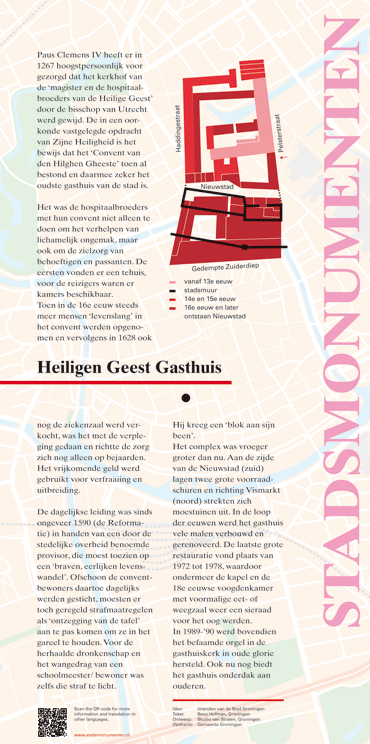021 - Heiligen Geest Gasthuis
Paus Clemens IV heeft er in 1267 hoogstpersoonlijk voor gezorgd dat het kerkhof van de ‘magister en de hospitaalbroeders van de Heilige Geest’ door de bisschop van Utrecht werd gewijd. De in een oorkonde vastgelegde opdracht van Zijne Heiligheid is het bewijs dat het ‘Convent van den Hilghen Gheeste’ toen al bestond en daarmee zeker het oudste gasthuis van de stad is.
Het was de hospitaalbroeders met hun convent niet alleen te doen om het verhelpen van lichamelijk ongemak, maar ook om de zielzorg van behoeftigen en passanten. De eersten vonden er een tehuis, voor de reizigers waren er kamers beschikbaar. Toen in de 16e eeuw steeds meer mensen ‘levenslang’ in het convent werden opgenomen en vervolgens in 1628 ook nog de ziekenzaal werd verkocht, was het met de verpleging gedaan en richtte de zorg zich nog alleen op bejaarden. Het vrijkomende geld werd gebruikt voor verfraaiing en uitbreiding.
De dagelijkse leiding was sinds ongeveer 1590 (de Reformatie) in handen van een door de stedelijke overheid benoemde provisor, die moest toezien op een ‘braven, eerlijken levenswandel’. Ofschoon de convent-bewoners daartoe dagelijks werden gesticht, moesten er toch geregeld strafmaatregelen als ‘ontzegging van de tafel’ aan te pas komen om ze in het gareel te houden. Voor de herhaalde dronkenschap en het wangedrag van een schoolmeester/ bewoner was zelfs die straf te licht. Hij kreeg een ‘blok aan sijn been’.
Het complex was vroeger groter dan nu. Aan de zijde van de Nieuwstad (zuid) lagen twee grote voorraadschuren en richting Vismarkt (noord) strekten zich moestuinen uit. In de loop der eeuwen werd het gasthuis vele malen verbouwd en gerenoveerd. De laatste grote restauratie vond plaats van 1972 tot 1978, waardoor onder meer de kapel en de 18e eeuwse voogdenkamer met voormalige eet- of weegzaal weer een sieraad voor het oog werden. In 1989-’90 werd bovendien het befaamde orgel in de gasthuiskerk in oude glorie hersteld. Ook nu nog biedt het gasthuis onderdak aan ouderen.


021 - Heiligen Geest Gasthuis
Pope Clement IV personally made sure that in 1267 the cemetery of the "master and hospital brothers of the holy spirit" was dedicated by the bishop of Utrecht. The documented mission of his holiness is the proof that the ""convent of the high spirit" already existed and was thus the city's oldest hospital.
The hospital brothers and their convent was not only to serve as a remedy against physical discomfort, but also to take pastoral care of the needy and passers-by. The former founded a home and for travelers there were rooms available. In the 16th century more and more people were incorporated into the convent " for a life time". When the infirmary was sold in 1628, the nursing completely focused on taking care of the elderly. The resulting funds were used for the beautification and expansion purposes.
Since around 1590(the reformation), the daily management had been in the hands of the provisor proclaimed by the city council, the provisor was assigned to supervise a "brave and honest way of life". Despite of the fact that the residents of the convent were daily instructed to fulfill that purpose, there were regular penalties like " the denial from the table" in order to keep them in line. For the repeated drunkenness and misbehavior of a teacher/resident the punishment was too light. In this case a block would be attached to his leg.
The complex used to be bigger in the past. On the side of the Nieuwstad (south) there were two large barns and towards the direction of the Vismarkt (north) vegetable gardens could be found. Over the centuries, the nursing home was remodeled and rebuilt many times. The last major renovation took place from 1972 to 1978, and it included the chapel and the 18th century guardian room with its former dining hall which was an ornament to the eye. In 1989-90 the famous organ at the hospital church was restored to its former glory. Even now the hospital still offers accommodation for the elderly.
Die Deutsche Übersetzung folgt.